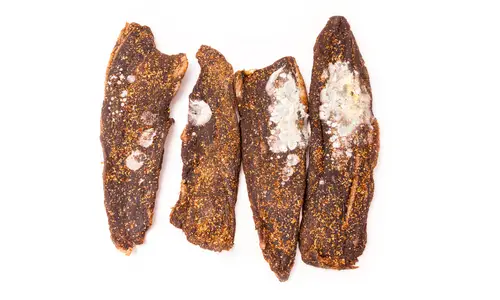Beef jerky is a delicious, low-fat, high-protein snack with a long shelf life.
So what are the tiny white specs you may be seeing on the surface of the meat? Is it mold or could it be something else? If it is mold, can it still be eaten? And how can you prevent this from happening in the future?
In this article, we will be answering all these questions and more, so keep reading!
Beef jerky can grow mold during curing, transportation, and at home if not stored properly. White, green, or black spider web-type growth is a clear indication of mold, and if found, the jerky should not be consumed.

Can jerky grow mold?
Beef jerky (like most foods), can indeed grow mold if the conditions it needs are met. Mold loves high humidity (55% and above), and dark environments with a lack of airflow and a source of nutrients.
Many types of mold can grow on cured meats, including white, green, and black strains, and in fact, in some preserved meats they are an essential component of the curing process.
The type of mold that could cause the most harm is black mold, and if this type is seen on your jerky, it is certainly best to throw it away, as it cannot safely be consumed.
Is the white stuff on beef jerky mold?
Whilst white mold is commonly found on persevered meats, it may not always be what you are seeing on your beef jerky.
To preserve the beef, curing salts are used to remove moisture, prolonging its shelf life. What you may be noticing are tiny white salt deposits on the surface of the meat. This is perfectly harmless and can be consumed.
Another white substance that can be mistaken for mold growth is fat. Beef has layers of fat running throughout the muscle fibers (called marbling), which is not only perfectly natural but enhances its flavor significantly.
What you may be seeing on the surface of your jerky, are small pockets of dried fat that have an off-white appearance. These are also perfectly safe to consume.
What does mold on jerky look like?
So, if there are substances that can be mistaken for mold, how can you be certain what you’re dealing with actually is mold in the first place?
The easiest way to tell comes from its texture. White mold has a powdery and fluffy appearance and can form in small asymmetrical clusters (sometimes similar to a spider web pattern). Green molds can also form this way.
Black, orange, and red molds also have a powdery texture and can form in circular patches, any signs of these types of mold mean that your jerky cannot be eaten and should be thrown away.
Why did your jerky become moldy?
There are several factors that mold needs to thrive, (as mentioned earlier in the article). If any of these conditions are met, either during the curing process, transportation or whilst storing at home, mold will certainly be able to accumulate on your beef jerky.
If recently purchased jerky is found to be moldy when you open the packet, you can be certain that the conditions to prevent mold during transportation or the curing process were not met, in which case, you can usually return the jerky to where you purchased it for a refund.
If instead, you find it has become moldy whilst it’s been in your home, then the way you stored the jerky is the number one culprit.
How to prevent jerky from going moldy
As poor storage conditions are the most likely cause of your jerky becoming moldy, this is the first place you should look to prevent it from happening again.
Mold needs moisture and a lack of airflow, so you need to store your jerky in the lowest humidity area of the kitchen you can find, preferably with some sort of vent. The areas of a kitchen with the highest humidity are usually located around the stove, where the kettle is kept, and near microwaves. If there are cupboards far away from these appliances, the humidity level will usually be lower.
If possible, store your jerky in a room of the house that is furthest from both the kitchen and bathroom. These are the rooms that are likely to have the lowest humidity and also tend to be cooler which will help to increase the shelf life of your jerky and prevent mold growth.
Mold also needs oxygen to grow, so storing it in an airtight container is a great first step to deny fungi the oxygen they require, however, you can go one step further by purchasing packs of oxygen absorbers to take the overall O2 levels below the point at which can grow.
How long does it take for jerky to grow mold?
Under the perfect circumstances, you can expect to begin to see mold formation begin within several days, to up to one week. Factors that can affect the speed of growth, are where and how the meat was hung, the humidity and temperatures of the location where the meat is stored, and the airflow of the room in which it is being cured.
Once cured, a sealed packet of jerky can last for up to one year as long as the packet remains unopened. However, if opened, and the humidity of the cupboard or room it is being stored in reaches 55% or higher, mold formation can begin within 24-48 hours.
Can you eat jerky with mold?
Molds found on jerky that has been purchased should not be consumed, as some strains can cause gastrointestinal discomfort and in immune-suppressed people, can cause severe allergic reactions.
White mold is commonly found on dried meat products, however, the strains of mold do not produce mycotoxins (more on this shortly). Once the jerky has been sold, if there is any mold found, it should be thrown away.
Any molds that have a black, orange, or red appearance can be considered to be toxic and therefore can cause severe reactions when consumed, so even more, care must be taken to ensure the jerky is mold free before consumption.
Is green mold on jerky bad for you?
Any signs of mold that has a greenish appearance should be taken as a signal to throw your jerky out. Whilst black mold is known to be toxic, green molds are also highly likely to cause digestive issues and potentially serious allergic reactions.
If you have accidentally eaten a very small amount of mold, (be it green or white), you may find that it doesn’t cause any effect, but no more should be consumed.
The confusion with this topic often comes about because during the meat curing processes of foods such as salami, certain strains of molds are encouraged to form as they actually help to cure the meat and enhance its flavor.
The difference here is that the molds that grow on these foods are specially selected, as they produce no mycotoxins, which are harmful toxins that can cause illness when consumed or inhaled.
These strains can often have a white or even green appearance but don’t be fooled into thinking that because of this the mold you found on your jerky is safe to eat, as many strains can have a similar appearance, but have very different properties. If you are uncertain in any way, you should throw the moldy jerky out.
What happens if I eat moldy jerky by mistake?
Very small amounts of green or white mold are unlikely to result in severe symptoms or gastrointestinal discomfort. However, even small amounts of black mold can cause severe reactions in some people.
The reality is that should you eat a piece of jerky without looking at it first, you will likely notice that it has a strange and unpleasant taste. If you then notice that the rest of the jerky in the packet also has mold, you should throw it away, but you may well not have any major symptoms from ingesting a very small amount, so there’s no real need to panic.
Can you get food poisoning from moldy beef jerky?
Mold can certainly make you Ill if you ingest it in high enough quantities, but it would not be classified as food poisoning, as this occurs when bacteria are ingested.
Instead, if mold has matured to the point of producing mycotoxins, and then been consumed, you are more likely to suffer from issues of the gut, stomach, and potentially even liver or kidney problems if the quantities were great enough.
For people that are allergic to certain strains of mold, there is also the possibility of itching, having a runny nose, coughing, and potential breathing problems in those with allergic asthma.
Does refrigerating jerky prevent mold?
Jerky does not need to be refrigerated, as it can be stored at room temperature for several weeks without issue as long as the above suggestions are used. However, an opened packet of jerky will require refrigeration to prevent the growth of bacteria.
Refrigerators have relatively high humidity levels, so mold will begin to grow if not stored correctly. To ensure mold does not grow, store the jerky in an air-tight container at the lowest point of the fridge or salad crisper, away from the back. If possible, place a few packets of silica gel in the container to absorb any moisture trapped within the container.
Your jerky should stay fresh and last anywhere from three to four weeks once refrigerated. Once the packet has been opened, remember that the flavors and texture will begin to fade.
Can freezing jerky prevent mold?
Absolutely, mold cannot grow in the temperatures found in freezers, so your jerky will stay fresh and edible for a considerable time in the freezer. It can be stored for up to one year safely if frozen.
An unopened packet can be frozen as it is, but jerky without a packet should be stored in an air-tight container to avoid it being damaged by freezer burn.
It’s important to note that whilst freezing your jerky will indeed increase its shelf-life considerably, it will also begin to lose its flavor and its texture will begin to deteriorate after a few months too.
How to tell if your jerky has gone bad
Beef jerky can become rancid and begin to grow mold if not stored correctly as described above.
You will be able to tell if your jerky has gone bad if:
1. There is a pungent, unpleasant aroma
2. Patches of mold have begun to form
3. The texture has become soft and mushy
Remember to consult the above paragraphs to determine whether or not your jerky is starting to deteriorate, or whether it is part of the natural process of salt crystal formation or pockets of fat.
Can moldy jerky be saved?
Unfortunately not, if you have inspected your jerky and found cobweb formation patches of white powdery substance forming on the surface, there is a high probability that mold has begun to form. If this is the case, the jerky should be thrown out and none consumed.
You may be tempted to try to save the remainder of the jerky left in the packet if there are no obvious signs of mold growth in the rest of the pack. This is best avoided, as spores can travel from one patch of the mold onto other pieces of jerky. These spores are not visible to the naked eye, so you may be consuming mold spores without your knowledge which could still make you ill.
Conclusion
From today’s article, you will have learned that beef jerky (and other types of jerky), can indeed grow mold. This is most commonly due to poor packaging, or poor storage once purchased. Moldy beef jerky should not be consumed as it can cause gastrointestinal issues.
If stored correctly, your beef jerky should last several weeks and can last up to one full year if frozen.

